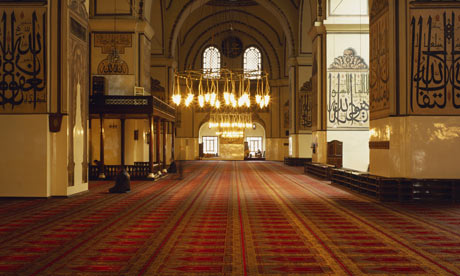
Iskender Usta could little have imagined, back in 1867 when he opened his Kebapci Iskender restaurant on Unlu Caddesi, Bursa's main drag, that the delicious new lamb dish he had invented would one day become the post-pub snack of choice for an alcoholic generation miles away in north-western Europe.
The ultimate, original example of the first kebab is served there still, in a little blue-fronted cafe with its bright white-wood panelled interior decorated with black and white photos of Iskender, brought out by smartly dressed men in white shirts and black waistcoats who claim to be his descendants.
I have rarely in my life been hammered enough to be tempted by more than a bite of a comrade's 4am kebab, but coming to Bursa it felt absolutely necessary to sample one of the originals, and thankfully Iskender's are a much better, tastier version of those that give rise to the hangover guilts at home.
Doner-style spiced lamb, shaved finely and layered thickly on a floury pitta comes with fat slivers of tomato and whole green chillis, tomatoey paste and salad. Alcohol isn't sold there, but the fresh red grape juice goes just fine. And the kebabs come on plates. With cutlery. Very sophisticated.
I ordered a portion, and my two local friends – both tall strapping lads – made the popular choice of a portion and a half (though they failed to finish them). When the platefuls were brought to our table, a second waiter hurried along behind with a silver bowl to ladle on the thick buttery sauce. We sat between a couple of Turkish families and happily munched in peace. Not a single drunken fight broke out.
Aside from the glory of having invented the Iskendar kebab, Bursa, a small city that is reached easily from Istanbul by ferry over the Sea of Marmara, has many other selling points.
As the first capital of the Ottoman empire, having been established in 200BC, and held by the Byzantines and Seljuks before falling to the founder of the Ottoman empire, Osman, it is full of wonderful Ottoman houses, mosques and tombs. Among those you can visit are Osman's, and that of his successor, Orhan, which sit together in the old part of the city, surrounded by a lush tea garden full of palms, which also house a six-storey clocktower, a little mosque and the tombs of various other sultans. Their silent marble encasements, illuminated by colourful rays seeping in through stained-glass windows and overhung with glass chandeliers, are a beautiful spot for quiet contemplation.
Bursa's atmosphere is of a mini, more traditional Istanbul. There is a fantastic old silk market, the Koza Han, in a stone complex around a courtyard with two levels of tiny shops where jewel-bright fabrics overflow from boxes and shelves to the ceiling. I bought half a dozen scarves for just a few pounds each, rainbows of plump woolly silks, and cool graphic prints on shiny satin – but resisted the kitsch ties with soft-focus photos of Ataturk's face.
The main souk, the Kapali Carsi, was a bit too much like a shopping mall, mainly selling food staples, cheap jeans and tacky minidresses, but worth a look to see the gaudy wedding jackets for boys – white faux fur with red velvet for an Elvis-meets-Santa look. Worth a trip, too, to witness men making fresh baklava in the bakeries, stretching long, looping strings of pastry between their hands.
The Ulumay Museum of Ottoman Folk Costumes and Jewellery (Ikincimurat Caddesi, 9am–7pm daily) is a surprisingly interesting treasure trove in a restored medrese. Tiny doorways led to room after murky room, where we were spooked by the creepy mannequins which suddenly started spinning when we entered, to show off ornate folk costumes from every region of Turkey, the Balkans and the Middle East. From long stripey woollen socks to rainbow-coloured wedding outfits, sequinned headdresses and belly dancing garb to some very fetching leather pantaloons for wrestling in, these were the sort of garments that could easily inspire a Gaultier or Galliano collection.
I didn't have chance to visit what promised to be a spectacular restored hammam, the Eski Kaplica, in Cekirge, the town's spa area, or the nearby Yeni Kaplica which records say was renovated in 1522 by Sultan Süleyman the Magnificent's grand vizier, on the site of an even older thermal bath. A house where Atatürk lived is another stop for your tick list.
And an hour's drive up a bendy mountain road through forest lies Uludag, the favourite ski resort of Istanbul's elite in winter, and a pretty place to cycle or stroll in summer.
But nothing could compare with Bursa's central mosque, the Ulu Cami on Atatürk Caddesi. Enormous, divinely beautiful, and certainly in a league with Istanbul's famous Haghia Sophia and Blue Mosques, its cream walls and high arches are dominated by huge swishes of Arabic, and the floor is swathed entirely in intricately patterned red carpet, where people sat alone cross-legged against the walls and beside radiators, murmuring their prayers. Some women wore long, flowing black robes, others wore jeans, and many including my guides, had bought special mosque shoes from a shop across the road – squishy leatherette slippers and the only kind allowed inside. No one batted an eye lid so see tourist visitors, though incredibly we were the only ones there. That such a bewitching city could lie so close to Istanbul, and be so off the radar is unfathomable, so go, at least to treat yourself to a proper kebab.
Hotel Gonluferah (+90 224 233 9210) dates from 1890, and has a hamam and spa. Doubles start at €105 including breakfast.

